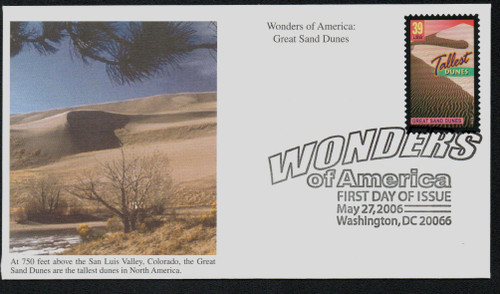
2006 39c Great Sand Dunes, Tallest Dunes
# 4037 - 2006 39c Great Sand Dunes, Tallest Dunes
$2.95
U.S. #4037
Great Sand Dunes
Wonders of America
Great Sand Dunes
Wonders of America
Issue Date: May 27, 2006
City: Washington, DC
Quantity Issued: 204,000,000
Printed by: Avery Dennison
Printing Method: Photogravure
Perforation: Serpentine die cut 10 ¾
Color: Multicolored
City: Washington, DC
Quantity Issued: 204,000,000
Printed by: Avery Dennison
Printing Method: Photogravure
Perforation: Serpentine die cut 10 ¾
Color: Multicolored
The Great Sand Dunes are in southern Colorado, at the eastern edge of the San Luis Valley and the western base of the Sangre de Cristo Range. There are about 6.2 billion cubic yards of sand in the dunes. The region has some of the highest inland dunes in North America, with crests reaching 750 feet.
The Medano and Sand Creeks carry loose sand from the east and north sides of the dune field and re-deposit it where prevailing southwestern winds can transport it back to the dune field. Over the years, sand and small dunes migrate in this southwestern wind pattern toward the ever-changing dune field.
In the 1920s, small quantities of gold were found in the Great Sand Dunes, and gold mining and sand extraction for cement production began. After San Luis Valley residents lobbied for protection of the Great Sand Dunes, Herbert Hoover established the Great Sand Dunes National Monument in 1932. President Clinton authorized its expansion into a national park in 2000.
Evidence of human existence in the area dates back to the Stone Age. Later inhabitants, like the Jicarilla Apaches, were long familiar with the region. The Ute tribe called the Great Sand Dunes sowapophe-uvehe, “the land that moves back and forth.”
U.S. #4037
Great Sand Dunes
Wonders of America
Great Sand Dunes
Wonders of America
Issue Date: May 27, 2006
City: Washington, DC
Quantity Issued: 204,000,000
Printed by: Avery Dennison
Printing Method: Photogravure
Perforation: Serpentine die cut 10 ¾
Color: Multicolored
City: Washington, DC
Quantity Issued: 204,000,000
Printed by: Avery Dennison
Printing Method: Photogravure
Perforation: Serpentine die cut 10 ¾
Color: Multicolored
The Great Sand Dunes are in southern Colorado, at the eastern edge of the San Luis Valley and the western base of the Sangre de Cristo Range. There are about 6.2 billion cubic yards of sand in the dunes. The region has some of the highest inland dunes in North America, with crests reaching 750 feet.
The Medano and Sand Creeks carry loose sand from the east and north sides of the dune field and re-deposit it where prevailing southwestern winds can transport it back to the dune field. Over the years, sand and small dunes migrate in this southwestern wind pattern toward the ever-changing dune field.
In the 1920s, small quantities of gold were found in the Great Sand Dunes, and gold mining and sand extraction for cement production began. After San Luis Valley residents lobbied for protection of the Great Sand Dunes, Herbert Hoover established the Great Sand Dunes National Monument in 1932. President Clinton authorized its expansion into a national park in 2000.
Evidence of human existence in the area dates back to the Stone Age. Later inhabitants, like the Jicarilla Apaches, were long familiar with the region. The Ute tribe called the Great Sand Dunes sowapophe-uvehe, “the land that moves back and forth.”







